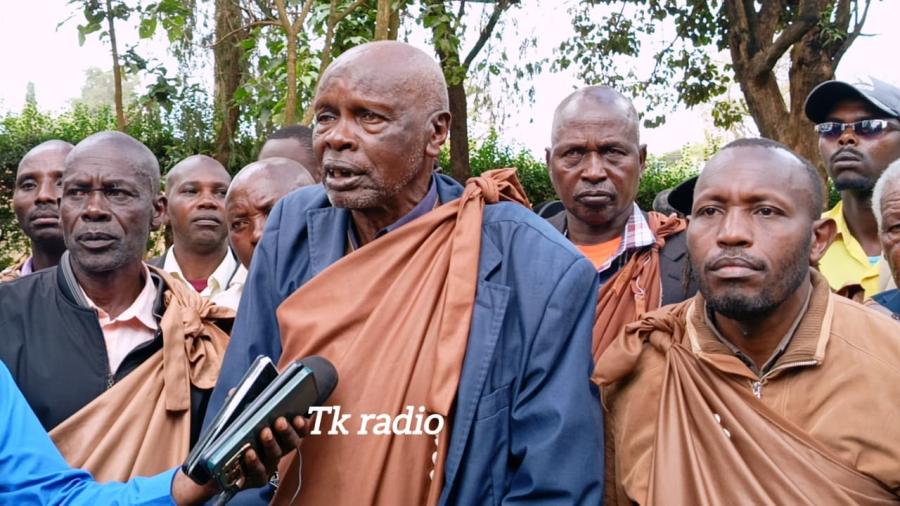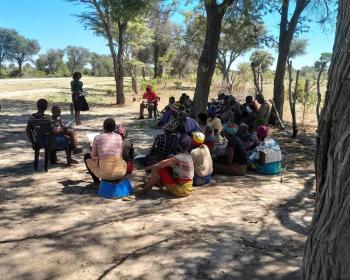San were the earliest occupants of present north-central Namibia. The Ovambo gradually settled and established kingdoms there, though the buffer zone between the San and Ovambo was preserved for a long time. (Williams, 1994) Studies show that the San played an important role in Ovambo society—the men as trading partners, the women as wives. The San were said to have exerted influence over Ovambo kingdoms through San women who were wives to kings of several Ovambo dynasties. (ibid.) San also served the kings as soldiers and executioners.
The German colony of South-West Africa (1885-1914) never reached northern Namibia. After gaining control of the area through the League of Nations mandate in 1919, South Africa started to dominate north-central Namibia through so-called Indirect Rule, exploiting the Four-Os region as a source of cheap labor. The need for cash pushed both the Ovambo and San into the southern part of the colony. Labor migration, based on individual contracts, weakened the San’s strong nuclear family ties.
The Finnish Lutheran Church began missionary activities in north-central Namibia in 1870. After long perseverance, missionaries won the confidence of local people, and their joint efforts to have an indigenous church gave birth to the current Evangelical Lutheran Church in Namibia (ELCIN). By the early 1960s, most of the San, who had previously lived in small-scale camps, were concentrated in villages under mission control. Partly because the missionaries promoted cultivation among the San, these villages had a flourishing agriculture. Some San were even educated as local leaders and conducted missionary work.
Missionaries also played an important role in the anti-Apartheid struggle; church leaders were in close contact with the South-West Africa People’s Organization (SWAPO). (Helberg, 1997) By the 1970s, the Liberation Movement became active. The South African Defence Force (SADF) built bases in north-central Namibia, and people who explicitly supported SWAPO retreated into Angola. The intensifying war interrupted ELCIN’s missionary work. The San who stayed in Namibia had to rely more on foraging. Because the SADF actively recruited the San, tension grew between the San and the Ovambo. But considerable numbers of San supported the Liberation Movement.
The people’s demand for freedom gained international support, which contributed to Namibia’s independence in 1990. Fighters and refugees—including San—returned to north-central Namibia. Several San development programs were started with high hopes, but according to an important recent study of the San’s status in Namibia, there has been little improvement. (Suzman, 2001) In towns, the San settle in back alleys. The lack of steady jobs leads to serious malnutrition and sickness. In rural areas, San make camps outside of Ovambo villages where patron-client relationships are frequently set up. The San workers are paid in cash or kind for their labor for the Ovambo. Other San stay in free-standing villages originally founded by the missionaries. After independence, missionaries were permitted to reopen their programs promoting San agriculture and literacy, but these programs were soon taken over by the Namibian government and rapidly declined as a result of budget cuts and cooptation by local power holders.
Recent months have seen an increase in tension between the San and their neighbors. In one example, an Ovambo man tried to gain control of a San community’s residential land by paying its land tax to the village headman. Headmen have the right to reallocate the land of absentees, and the San’s mobile lifestyle can be a pretext for dispossession. Expanding Ovambo settlements have steadily encroached on wilderness areas and have driven game away. The San, for their part, have been involved in increasing stock theft. Active intervention by churches, non-governmental organizations, and the government will be necessary to defuse these tensions and avert further San impoverishment.
References & further reading
Helberg, C. (1997). Mission colonialism and liberation: The Lutheran Church in Namibia 1840-1966. Windhoek: New Namibia Books.
Suzman, J. (2001). An assessment of the status of the San in Namibia. Windhoek: Legal Assistance Centre. Five Volumes.
Williams, F. (1994). Precolonial communities of Southwestern Africa, A history of Owambo Kingdoms 1600-1920 (2nd ed.). Windhoek: National Archives of Namibia.



